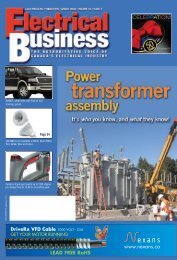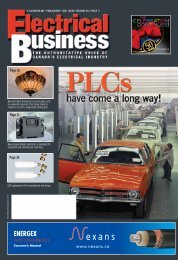From the Legal DeskFurther confusing what work is lienableOntario Court of Appeal releasesdecision upholding Kennedy v DanaBy Stephen Tatrallyay, LLBStephen Tatrallyay is a prominent Torontoconstruction lawyer and can be reachedvia e-mail at statrallyay@rogers.com or bycalling (416) 482-5164. He is also a memberof EB’s Editorial Advisory Board.Be careful! It would seem claims for lien are not availableto suppliers of non-construction equipment to a “bricks andmortar” base building—even when its entire purpose is tocontain such equipment and produce something with it.Near the end of September, the Court of Appeal releasedits unanimous decision upholding the majority decisionof Divisional Court in Kennedy Electric v DanaCanada Inc. 1This means that claims for lien are not available to suppliersof non-construction equipment to a “bricks and mortar”base building—even in circumstances where the entire purposeof construction of the base building was to contain suchequipment and produce something with it.In this case, Dana Canada Inc. owned land in St. Mary’s,Ont., as part of its production facility for Ford vehicleslocated there. Dana decided to construct a building on theland in St. Mary’s to house the assembly line for a new line ofpickups. The evidence at trial was that there was not muchinteraction between the building designer and the designerof the assembly line, Rumble Automotive, to determine theconfiguration of both building and assembly line, but that itwas always the intention of all concerned to use the buildingto contain the assembly line.Rumble designed the line and hired Kennedy Electric toactually construct it. The work consisted of the erection andinstallation of more than 100 mezzanine platforms, eachpurpose-designed to hold one or more of the pieces of equipmentnecessary to the assembly line, covering about 100,000sf of the floor of the building, weighing about half a milliontonnes and standing, on average, 20-ft high.The work was in two phases: first, a mock-up of theline had to be built in Rumble’s facilities in Mississauga toensure it actually worked, then the whole thing had to bedismantled by Kennedy, shipped to St. Mary’s by truck andreassembled. It was “attached” to the building by thousandsof mechanical and chemical bolts. To detach the equipmentwould result in the cutting of those bolts and inevitabledamage to the floor.Unfortunately, there was a falling out between Rumbleand Kennedy which resulted in Kennedy allegedly not beingpaid several million dollars and, in turn, not paying someof the subtrades that worked for it. Kennedy and somesubtrades liened the project and started actions to enforcetheir claims. The question of lienability was brought to trialbefore Justice Killeen sitting at London. In a decision renderedlate in 2004, Killeen held that the work in questionwas not lienable.I served as counsel for Kennedy at trial and admit to abias in Kennedy’s favour. Killeen conducted a very thoroughreview of the case law, referring to every case brought to hisattention. He indicated that he was bound by the SupremeCourt of Canada’s 1963 decision in Ace Lumber v ClarksonCo. Ltd., to the effect that, because a Mechanic’s Lien was createdby statute, the legislation should be given a strict determinationof what types of claims could be protected by it.After recognizing that the entire case turned on the definitionof “improvement”, but without really considering themeaning of that word himself, the trial judge turned to thereport of the original committee which drafted the act and,specifically, to their definition of “improvement”:While the definition... is broad, the Committee hasattempted to draft it in such a way that it will be clearthat the lien created by the Act applies only in the caseof the construction and building repair industries.He also cited the Ontario Court of Appeal’s 2001decisionin Central Supply v Modern Tile, where the Court seems tohave approved such an analysis.The only prior Ontario appellate court decision he couldfind supporting that approach was from back in 1952,decided under an earlier act with a totally different definitionof “improvement”. Cases from other provinces, whilegenerally supportive of his approach, were by no meansunanimously so; indeed, the B.C. decisions seem to haverecently begun to go the other way. The judge distinguishedthese on the basis of different wording in the definition of“improvement” in the B.C. Act (notwithstanding that it isactually more restrictive than Ontario’s).Killeen’s expressed reason for rejecting the lien was that,while the machinery was to be bolted to the floor of the plantbuilding—and lines for the layout painted on the floor—itwas admitted that all of the base services were installed by theconstructor of the base building, and that it was outside thescope of Kennedy’s contract to even hook up to them. Thetrial judge was also impressed by evidence that Dana had, onoccasion, disassembled similar systems in other plants, movedthem elsewhere and reassembled them. (In this case, though,there was no evidence of any intention on Dana’s part of doingthis. Indeed, the contract between Dana and Ford specifiedthat the equipment remain in that location to produce thatline of trucks for at least eight years.)The Prime Contract specified that no liens were to betolerated on the project, and must be removed forthwith.Kennedy’s contract was silent on the point, although it didprovide for a 20% holdback until job completion. AlthoughEligible Toronto buildingscan get a cash-back rebateof up to 40% of their costs.Contact the BOMA Toronto CDM Program for detailsINFO NO. 15416-440-0101 www.bomacdm.comBOMA_EB_Oct07.indd 114 • NOVEMBER/DECEMBER 2007 • www. mag.com10/16/07 3:15:46 PM
From the Legal DesklettersKennedy strongly emphasized the fact that the planthad been specifically purpose-built, and that it andthe equipment must be treated as one integratedwhole, the judge disagreed and found that—in itsessence—there were two separate contracts. Onewas just a building and could have been put to anyuse. This was lienable. The other, which was not,was the supply and installation of equipment forcommercial purposes which could have gone anywhere,given the proper specifications of the buildingit was to be put in.Although his mandate did not require him todo so, the trial judge also made a broad statementto the effect that the installation of anyequipment for commercial usage could never belienable because the Construction Lien Act wasexclusively intended to assist those in the “constructionindustry”, even though the act does notexpressly say so.There was considerable concern about the decision,particularly in the electrical and mechanicalsections of the construction industry. Theimplications are obvious—the old “chattels versusfixtures” debates are no longer relevant. The installationof commercial machinery is not lienable,and any contract between owners and contractorsperforming such work must be revised to protectpayment rights and provide quick remedies.On first appeal, a majority decision in DivisionalCourt upheld Justice Killeen’s decision, albeit witha strong dissent by Madame Justice Chapnick. 2The matter then proceeded, with leave, to theCourt of Appeal. That court released its decision,rejecting the appeal, on September <strong>27</strong>.The court’s basic reason for dismissing theappeal was that the trial judge made findings offact supported by at least some of the evidencebefore him, and an appellate court should notinterfere with such findings of fact (except whenthere is clear evidence that the trial judge did notunderstand the evidence or misinterpreted it).On the question of portability of the assemblyline, therefore, Justice Armstrong held that,“While a different judge may have come toanother conclusion on the issue of portability, Iam satisfied that it was open to the trial judge toreach the conclusion that he did”. While it is niceto see the court approving this often-neglectedprincipal of deference to the trial judge—which itdoes not always do—it is always available to themto change the decision if the judge has misappliedlegal principles to those facts.An incorrect statement or application of a legalissue can and should be reviewed by the appellatecourt without deference. I believe this is whatJustice Chapnick was trying to do at the DivisionalCourt level. The Court of Appeal, however, decidedthat the judge was making findings of fact(which could, in theory, be supported by evidencebefore him) and applying the law based on thosefindings. Applying this approach, he had the rightto be wrong as long as his findings were based onsome evidence.Contractors supplying these types of equipmentor materials—and their lawyers—are advised toreview and carefully consider the implications ofthe decision on their own businesses.Notes1. Kennedy Electric Ltd. and Cassidy IndustrialContractors Ltd. v Dana Canada Corp. 2007ONCA 664 (2007) 61 CLR (3d) 1; decision ofOntario Court of Appeal, released Sept. <strong>27</strong> 2007).2. (2006) 50 CLR (3d) 283 (Ont. Div. Ct).Transported to New YorkI enjoyed reading the article about relighting the historic CustomHouse on page 40 in the October 2007 edition. It was so well writtenthat I seemed transported to the site, even though I was never therebefore and have never seen any pictures.Are there any ‘before’ and ‘after’ pictures available, please?— Harald T.Check out www.oldnycustomhouse.gov— Ed.Let’s focus on the good!I was just reading your letter from Brian B. complaining about theHouse of Horrors, and he’s absolutely right (EB Sept 07, “Horrified byhouse of horrors”, page 6). We all slow down to look at car accidents,and this is our version of that same scenario. Perhaps there should bea showcase feature to run alongside the House of Horrors spotlightingcontractors that provide quality workmanship.I am an electrical contractor [that mostly does] custom cottages. Ihave always felt that when terminating the electrical panel it is importantto put a little pride into it and do the best that you can. Whenyou visit a home and end up in the mechanical room, you’re going tonotice the panel—so if the rest of the house looks good, then so shouldthe panel. I was once told that every trade reflects on one another.When a home shows well but the panel is a dog’s breakfast, it bringsdown the quality of the overall project.Also, the panel is about the only place a residential contractor canshow his stuff; everything else is just devices. I’ve never been asked,“Hey, did you install those receptacles? Nice job”. A neat electricalpanel shows pride and craftsmanship. Time-wise I’m pretty sure itworks out about the same [as a sloppy job] when you prepare and thinkabout your approach to the job. Neat workmanship also also generateswork because when someone sees a job well done, and they’re in themarket for an electrical contractor, you will be getting that call.Thanks, and I’ll look forward to next month’s <strong>Electrical</strong> <strong>Business</strong>, asthere are always interesting articles inside.— James P.Introducinga new lineof CAT IVInsulationTesters!Hammond NewsHammond Manufacturing is proud to offer our full-line E5 standardproduct catalog. This 500 page book adds over 1000 new SKU's to ourprevious edition.Sloped Top - <strong>Page</strong> 76RAL7035 Wallmount - <strong>Page</strong> <strong>32</strong>NEW Megger MIT400 SeriesThe high performance testerperfect for commercial andplant electricians CAT IV 600 V Rated Adjustable Insulation Test Voltages –provides 10 V to 1000 V Exceptional measurement rangefrom 20 G to 200 G Pass/Fail Limit Alarm Automatically performs PolarizationIndex tests True RMS voltage measurement Results storage and wireless Bluetooth TMdownload 3 year warrantyWWW.MEGGER.COMNew products added:• Numerous standard size stainless steel enclosures• Sloped top enclosures - mild and stainless steel• Eclipse wallmount enclosures available in RAL7035• Full line of commercial boxes and splitters• OEM friendly polyester enclosure line - PJU Series• Enhanced climate control offering• Much, much moreCommercial Box - <strong>Page</strong> 342OEM Polyester - <strong>Page</strong> 122Contact your Hammond Distributor or visit us online atwww.hammfg.com to get your catalog today.Hammond Manufacturing Co. Ltd394 Edinburgh Road NorthGuelph, Ontario N1H 1E5Offices in Montreal, Edmonton, Toronto1-800-297-9688Info no. 16Tel: (519) 822-2960 or (905) 456-3770Fax: (519) 822-0715sales@hammfg.comwww.hammfg.comInfo no. <strong>17</strong>Megger_EB_May07.indd 15/7/07 11:46:01 AMwww. mag.com • november/december 2007 • 15
















